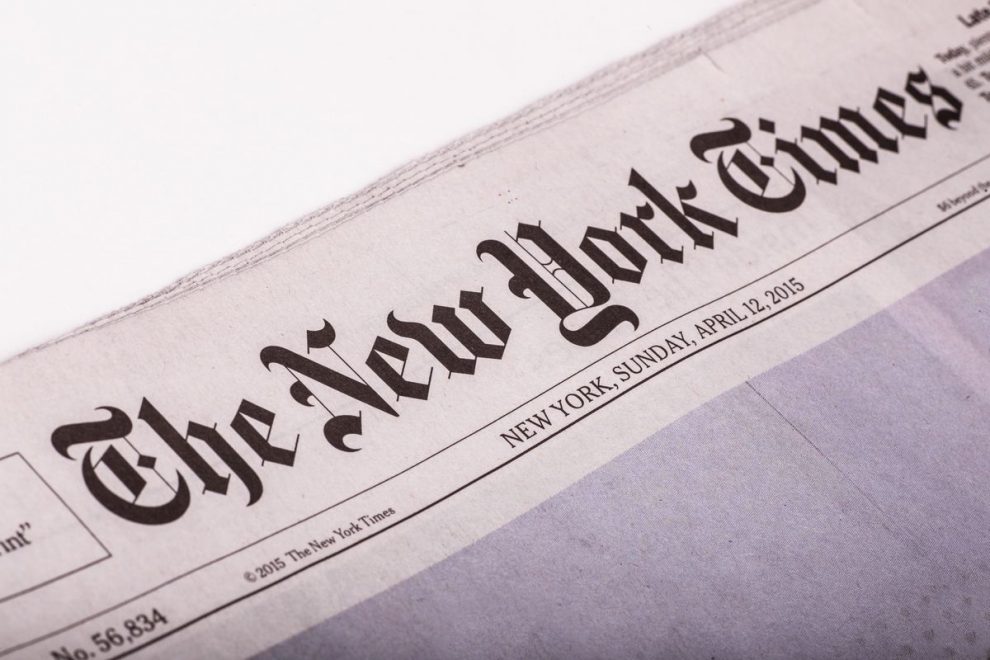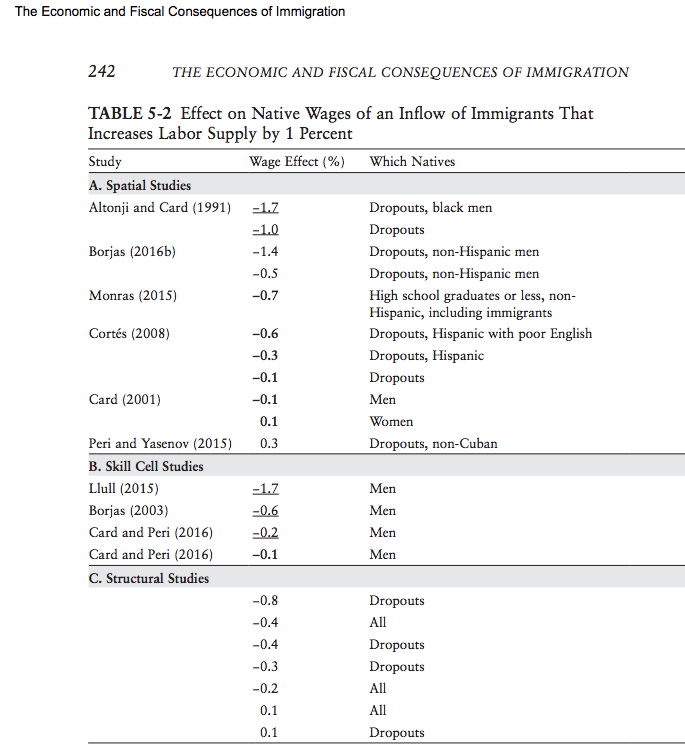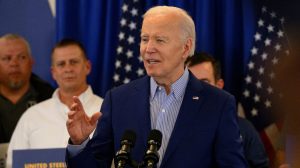The New York Times is hiding the huge impact of immigration on Americans’ wages to help portray President Donald Trump’s policies as “anti-immigrant.”
The paper’s dismissal of economics is buried deep in a long and critical article about Trump’s immigration policy and his top aide, Steven Miller. The dismissal allows the article to comply with the August 12 instructions from the NYT‘s senior editor who urged reporters to treat public debates over immigration policy as racial conflicts, not as disputes over money, wages, salaries, profits, and stock prices.
The article’s subheadline claims the nation’s immigration policy is now driven by hostility towards individual immigrants, not by the widespread public opposition to the painful economic distortions caused by the government’s support for mass migration: “Behind Mr. Miller’s singular grip on the Trump anti-immigrant agenda are forces far bigger than [Miller’s] own hostility toward the foreign-born.”
The NYT reporter, Jason DeParle, dismissed the public’s concerns about jobs, wages, and housing prices with a few vague sentences crediting unnamed “economists”:
The impact of immigrants on jobs and wages is much debated — they take jobs but make jobs, too. Most economists see greater downward pressure on wages coming from other forces, including the decline of the minimum wage (adjusted for inflation), weak unions, outsourcing and technological change.
Yet DeParle’s admission of “greater downward pressure” indirectly admits that immigration does exert some downward pressure on wages. His mention of “other forces” also hides the indirect economic effect of mass immigration, such as companies’ ability to break unions by hiring refugees and illegal migrants for jobs in meatpacking, construction, and restaurants.
DeParle also cited the misleading summary issued by the National Academies of Science to cover up the dynamite results of its 643-page, landmark study of immigration economics in 2016. DeParle wrote:
The National Academy of Sciences concluded in 2017 [sic] that immigration’s overall effect on wages was “very small,” but added that “some studies have found sizable negative short-run impacts for high school dropouts” (who account for about 8 percent of the work force). Even among dropouts, some economists find the effects modest or nonexistent.
But the summary by the National Academies downplays the data and statements in the report which admit that imported workers cut Americans’ wages.
For example, on page 171 of its September 2016 report, the academies’ experts agreed to a formula which shows that immigration imposes a 5.2 percent income tax on Americans:
Immigrant labor accounts for 16.5 percent of the total number of hours worked in the United States, which . . . implies that the current stock of immigrants lowered [Americans’] wages by 5.2 percent.
The NAS panel declined to state the dollar value of the 5.2 percent immigration tax. But panel member George Borjas, a Harvard economist, calculated the value of the tax at $500 billion a year.
This $500 billion immigration tax is not paid to the government — it is paid by employees to employers and investors who gain whenever wages are lowered by the increased supply of workers jostling and competing for wages. That’s a political boon for Democrats because economic pressure tends to push Americans to vote for the big-spending party.
Many Americans are already working in chicken processing factories, and more will take the jobs when low-wage illegals are sent home and the starting wages are pushed up. Another win for Econ 101: supply & demand. https://t.co/p5QS6KccV8
— Neil Munro (@NeilMunroDC) August 13, 2019
The immigration tax of $500 billion is a huge loss for the many American families who are already hurt by automation and globalization, by the rising cost of education, housing, childcare and healthcare, and by Wall Street’s constant pressure for spending cuts and payroll curbs. Small wonder that many Americans feel under intense economic pressure to vote for the big-spending giveaway Democrat Party.
On page 242, the NAS report also showed 18 studies which describe the wage losses caused by the government’s policy of importing labor:
“The evidence suggests that groups comparable to the immigrants in terms of their skill may experience a wage reduction as a result of immigration-induced increases in labor supply, although there are still a number of studies that suggest small to zero effects,” the report said on page 248.
The NAS report also hides the impact of immigration on wages by arguing that wages will rise once the economy expands to provide jobs for all the immigrants, so forcing employers to start paying fair market wages. The summary said, “When measured over a period of ten years or more, the impact of immigration on the wages of natives overall is very small.”
But the problem with NAS ten-year claim is that the long-run never arrives because the government keeps providing roughly 1 million more new legal immigrants each year, plus a population of roughly 1.5 million visa-workers, at least 2 million people with work permits, plus at least 8 million working illegals.
When asked, many economists and even business groups quickly — but reluctantly — admit that wages are cut by the government’s policy of boosting the labor supply with migrants. Breitbart News has extensively covered those admissions.
The Senate’s 2013 “Gang of Eight” immigration bill would have shifted more of the nation’s new wealth from employees over to investors, according to the 2013 study of the bill by the Congressional Budget Office. “The rate of return on capital would be higher [than on labor] under the legislation than under current law throughout the next two decades,” says the report, titled “The Economic Impact of S. 744.”
The CBO report also repeated the NAS claim that wages would rise once the economy eventually provides jobs for all the new immigrants. “Average wages would be slightly lower than under current law through 2024, primarily because the amount of capital available to workers would not increase as rapidly as the number of workers and because the new workers would be less skilled and have lower wages, on average, than the labor force under current law,” the CBO said. But the promise of a future rise in wages would be dashed if the government again expanded immigration.
In 2016, many establishment media out and staffers for Hillary Clinton’s campaign touted a study by the Wall Street advisory firm Moody’s Analytics. The study said that candidate Donald Trump’s promise to deport migrant labor would raise Americans’ salaries: “As the immigrants leave, the already-tight labor market will get tighter, pushing up labor costs as employers struggle to fill the open job positions. … Mr. Trump’s immigration policies will thus result in… potentially severe labor shortages, and higher labor costs.”
In 2016, Moody’s reported that the deportation of illegals in Arizona spiked Americans’ wages:
The median income of low-skilled whites who did manage to get jobs rose about 6% during that period, the economists estimate … wages rose about 15% for Arizona farmworkers and about 10% for construction between 2010 and 2014 … Some employers say their need for workers has increased since then, leading them to boost wages more rapidly and crimping their ability to expand … graduates [at a federal job-training center] now often mull two or three jobs offers from construction firms and occasionally start at $14.65 an hour instead of $10 … At DTR Landscape Development LLC, the firm’s president, Dick Roberts, says he has increased his starting wage by 60% to $14.50 an hour because he is having trouble finding reliable workers.
The business school at the University of Pennsylvania has issued several reports say that less immigration will slow the expansion of the economy. When pressed by Breitbart News, the group’s leader, economic professor Kent Smetters, admitted that Trump’s 2017 immigration reduction plan would raise Americans’ wages for the next 33 years: “By 2027, wages increase a small amount (0.231%) relative to baseline; by 2040, wages increase by an even smaller amount (0.158%).” The school is backed by several investors who stand to gain from an increased inflow of consumers and cheap workers.
In February 2018, former treasury secretary Robert Rubin told a D.C. meeting at his Hamilton Project that wages rose in the 1990s because there was a shortage of workers. “First in the mid-90s, earlyish, and then rest of the 1990s, as we all know, wages increased at a robust level at all quintiles, and that was in some fair measure, due to tight labor markets, which in turn, at least in my, view, were a function in some fair measure, of good policy.” Rubin’s resume includes 26 years at Goldman Sachs, four years as President Bill Clinton’s Treasury secretary and ten years running the Citigroup banking firm, during a decades-long period when Americans’ wages were mostly flat.
Foreign economists admit the obvious. The Central Bank of Ireland recently reported that “an increase in inward migration can help to mitigate overheating dynamics in the labour market … Typically, employment growth at or above the “full employment” level is accompanied by strong growth in wages and prices. As the supply of labour is scarce relative to demand, workers’ bargaining power increases and the price of labour increases.”
Business advocates commonly say immigration has little impact on wages — but also that higher immigration can prevent wage raises. For example, the editorial board of the Wall Street Journal wrote in August 2017:
Every economist knows that employers can only raise wages as fast as productivity and profitability allow. If the cost of labor rises too much for a specific job, employers will simply cease providing the service or move production overseas. That means fewer jobs for Americans too … The solution, as ever, is a legal immigration system that is generous with visas and flexible enough to meet the demands of a growing U.S. economy.
President Barack Obama admitted the obvious several times. For instance, in his January 2016 State of the Union Address, he said: “immigrants aren’t the principal reason wages haven’t gone up enough; those decisions are made in the boardrooms that too often put quarterly earnings over long-term returns.” In his 2006 autobiography, Obama wrote “this huge influx of mostly low-skill workers provides some benefits to the economy as a whole… [but] it also threatens to depress further the wages of blue-collar Americans.”
White-collar graduates also lose salaries and careers to immigration, according to a 2013 report by left-of-center academics:
For every two students that U.S. colleges graduate with STEM degrees, only one is hired into a STEM job.
In computer and information science and in engineering, U.S. colleges graduate 50 percent more students than are hired into those fields each year; of the computer science graduates not entering the IT [information technology] workforce, 32 percent say it is because IT jobs are unavailable, and 53 percent say they found better job opportunities outside of IT occupations. These responses suggest that the supply of graduates is substantially larger than the demand for them in industry.
Mass immigration also reduces employees’ income by forcing them to pay more for housing. The impacts include a claimed $3.7 trillion jump in real estate values, and the increased pressure by elites on other Americans to reduce the “single-family zoning” rules which created suburbia. The same supply and demand factor operates in Ireland, where the Central Bank reported that “Higher migration, however, also increases the demand for housing putting upward pressure on house prices
But the impact is especially clear outside the New York Times‘ front door, where local residents blocked the arrival of Amazon because it would spike rental costs: “An analysis conducted in April by Zillow found that renters’ costs could increase by more than $200 annually in the two cities relative to the real-estate site’s base cases if Amazon were to set up in them,” Business Insider reported November 2018. In August 2019, the Daily Mail showed how one New York landlord split one apartment lengthwise into nine spaces of five-foot-high rooms, each renting for $600 per month.
The immigration-fueled real-estate growth along the costs is also helping to slow economic growth in America’s heartland. Coastal investors have little need to hire young workers in distant Kansas, Oklahoma or Kentucky because the government keeps flying new foreign workers into Los Angeles, New York, North Carolina, New Jersey, Florida, and Seattle.
This huge shift in population, and the resulting drop in wages has pushed the coastal states further and further into the Democrat columns on election day. In contrast, the GOP does well with young people who can afford homes and families in states with fewer migrants and small wealth gaps.
But DeParle’s effort to dismiss the impact of the economic impact of mass migration complies with his newspaper’s new race-before-money editorial policy.
The policy was described August 12 by executive editor Dean Baquet in a closed-door meeting with reporters and editors, when he said the newspaper is going to focus on the impact of slavery and racism throughout American politics during the runup to the 2020 elections. The public’s worries about migration’s impact wages are to be treated in the same fashion as articles about Fox News, on “anti-immigrant conspiracies,” or religious opposition to abortion, he said:
Our job is to figure out why, and how, and to hold the administration to account … The same newspaper that this week will publish the 1619 Project, the most ambitious examination of the legacy of slavery [in the United States] ever undertaken in [inaudible] newspaper, to try to understand the forces that led to the election of Donald Trump. And that means trying to understand the segment of America that probably does not read us. The same newspaper that can publish a major story on Fox News, and how some of its commentators purvey anti-immigrant conspiracies, also has to talk to people who think immigration may cost them jobs and who oppose abortion on religious grounds.
Even if immigration has no impact on wages and rents, the New York Times article collides with the reality that Trump has repeatedly said he wants to welcome immigrants to the new jobs in his go-go economy. “We want to allow millions of people to come in . . . We have to have legal immigration, not illegal immigration,” Trump said August 7:
"We want to allow millions of people to come in . . . We have to have legal immigration, not illegal immigration." pic.twitter.com/avZsfRZWFh
— The White House (@WhiteHouse) August 7, 2019
The NYT article is not entirely off-base. For example, it does admit that Breitbart’s follow-the-money coverage of the immigration issue has had an impact on Americans’ politics, saying “right-wing populism had long flourished on talk radio, but Breitbart, with few restrictions on space, could cover the issue in greater depth, bringing intense scrutiny to hot-button issues.”
Immigration Numbers:
Each year, roughly four million young Americans join the workforce after graduating from high school or university. This total includes about 800,000 Americans who graduate with skilled degrees in business or health care, engineering or science, software, or statistics.
But the federal government then imports about 1.1 million legal immigrants and refreshes a resident population of roughly 1.5 million white-collar visa workers — including approximately 1 million H-1B workers and spouses — and about 500,000 blue-collar visa workers.
The government also prints out more than one million work permits for foreigners, tolerates about eight million illegal workers, and does not punish companies for employing the hundreds of thousands of illegal migrants who sneak across the border or overstay their legal visas each year.
This policy of inflating the labor supply boosts economic growth for investors because it transfers wages to investors and ensures that employers do not have to compete for American workers by offering higher wages and better working conditions.
This policy of flooding the market with cheap, foreign, white-collar graduates and blue-collar labor also shifts enormous wealth from young employees towards older investors, even as it also widens wealth gaps, reduces high-tech investment, increases state and local tax burdens, and hurts children’s schools and college educations.
The cheap-labor economic strategy also pushes Americans away from high-tech careers and sidelines millions of marginalized Americans, including many who are now struggling with fentanyl addictions.
The labor policy also moves business investment and wealth from the Heartland to the coastal cities, explodes rents and housing costs, undermines suburbia, shrivels real estate values in the Midwest, and rewards investors for creating low-tech, labor-intensive workplaces.
Indian govt & companies declare support for bipartisan HR.1044 & S.386 bills which expand the outsourcing of US college-grad jobs to Indian grads. Well, of course – outsourcing is India's economic strategy. So why should it be bipartisan US strategy too? https://t.co/xjSDjwYaEL
— Neil Munro (@NeilMunroDC) July 25, 2019
Story cited here.
Scroll down to leave a comment:






























